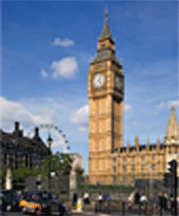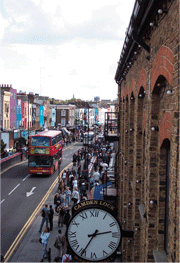LONDON CALLING
London surrounds you with a history that stretches back two millennia yet has the feel of a boomtown, a palpable charge in the air that says something is about to happen and that what happens here will reverberate around the world.
By: Patrick J. Kelly

No need for a car. London is so pleasant to stroll that you can become completely lost before you realize it.
Twelve hours out of Houston, and I can't tell where my behind ends and my coach-class seat begins.
At mid-life I've finally made the hop across the pond to explore London, the only European city I feel connected to. As I grew up in Texas, my dad, who was stationed in England in World War II, told me stories about this world capital that Germany tried to destroy. In those dark times, he said, the free world clung to BBC radio broadcasts that always opened with, "This is London calling.”
As my flight sets down at Gatwick airport, I glance at a worn photo of my dad posing at the statue of Eros in Piccadilly Circus. The evening that photo was taken, German V-1 buzz bombs hit London, and my dad spent the rest of the night pulling bodies from the rubble of a church basement, where children had been celebrating a birthday party.
Now, on my own first night in London, I've found the statue of Eros, backlit by blinding neon advertising, Times Square style.
The sculpture, says a brochure I'm holding, was once said to depict the angel of Christian Charity rather than the Greek god of love. Tell that to the teens making out beneath it. Locals, the brochure says, dismiss Piccadilly Circus as a "tacky melee" best left to tourists. Perhaps. But I can ignore the crowds. Truth is, I feel a sweet twinge of closure, standing precisely where my father stood over 60 years ago.
Next day, I'm 440 feet above the River Thames riding the London Eye, a futuristic Ferris wheel with curved glass passenger capsules. The view is helping me get my bearings in this sprawling metropolis of 7.5 million people. I can clearly make out the two cities that, along with 31 boroughs, make up London: Across the river to my left is Westminster -- with the Houses of Parliament, Westminster Abbey, and Somerset House. And off to my right is the City of London, a world financial center bursting with banks and corporations, which elects its own mayor and has the site that gave London its name, Londinium, the Roman settlement founded around A.D. 50.
London grew dramatically in the 274 years that separate its two most horrific disasters -- the Great Fire of 1666, which destroyed 80 percent of the city, and the Blitz of World War II -- but the modern city still reflects its medieval layout. It's a haphazard warren of streets that change names and morph into crescents, with squares designated upper, lower, east and west. The roads lead to courts and cloisters, palaces and castles, gleaming business districts, ethnic neighborhoods, and, always, well-landscaped parks and gardens.
No need for a car. London is so pleasant to stroll that you can become completely lost before you realize it. Ambling along Oxford Street to Madame Tussauds Wax Museum, I'm sucked into the bustle of a posh area called Mayfair, where Georgian architecture is wedged among shopping arcades and cobblestone alleyways.
Tom Jones is the first mannequin I recognize at the celebrity party raging inside Madame Tussauds. The Welshman is resplendent in full lounge kit, and I can almost see him sweat. When I snap Morgan Freeman's picture, he's so lifelike, I swear he blinks. Nicolas Cage, Brad Pitt, and Susan Sarandon look crazy, girlish and bored, respectively. Downstairs in the World Stage room, tourists from India pose with Gandhi; folks from Africa pose with Mandela; and everyone lines up to have their picture taken with the royal family.
 Next morning I'm standing firm before Buckingham Palace awaiting the Changing of the Guard, wondering if I might have my own brush with royalty. The act lasts about 40 minutes. The stamping of boots, orders shouted unintelligibly, arms presented and shouldered, and show tunes, it's all here. I follow the band as it makes its way down the Mall, the grand, tree-lined avenue draped with giant Union Jacks during state occasions. Cutting through St. James's Park, I see tall, distinguished member-of-Parliament types discussing weighty issues and motioning with their umbrellas. Even the pigeons in this park strut around with purpose.
Next morning I'm standing firm before Buckingham Palace awaiting the Changing of the Guard, wondering if I might have my own brush with royalty. The act lasts about 40 minutes. The stamping of boots, orders shouted unintelligibly, arms presented and shouldered, and show tunes, it's all here. I follow the band as it makes its way down the Mall, the grand, tree-lined avenue draped with giant Union Jacks during state occasions. Cutting through St. James's Park, I see tall, distinguished member-of-Parliament types discussing weighty issues and motioning with their umbrellas. Even the pigeons in this park strut around with purpose.
I decide to treat myself to a hallowed English tradition: high tea. And I shall take it at Harrods, London's premier department store, where I expect to be treated like a king myself. When I see Harrods, I first think I'm back at Buckingham Palace. It's an ornate, six-story building housing 330 departments whose motto was once: "Omnia Omnibus Ubique -- All things for all people, everywhere.”
Back in my dad's day, parts of Harrods were requisitioned to serve as military headquarters. Workers made uniforms, parachutes and bomber parts here. I take a side entrance and cruise past food halls to the Egyptian Escalator, which takes me to the fourth-floor restaurant. A tux is tinkling away on a grand piano.
High tea includes fresh mini sandwiches, pastries, scones with clotted cream and preserves, and three or four slices of no-apologies desserts. Takes me four pots of Earl Grey to finish it off. Most civilized.
I hop a bus and head east to Britain's most famous and infamous landmark, situated on the banks of the Thames: the Tower of London. Begun as a fortress in 1066 by William the Conqueror, it has survived for over 900 years as a palace, prison, place of execution, arsenal, mint, jewel house and zoo. It has been a popular tourist attraction for centuries. I follow the latest batch of visitors through Middle Tower, which guards the bridge across the moat (now filled with grass), and on to Byward Tower, which looms above the entrance to the outer defensive wall. Although I enter as a free man, there's a spooky feel to this 18-acre compound.
Heading deeper into this closed world I come upon the infamous Traitors' Gate, the river entrance used by many high-profile prisoners slated for execution. The decapitated heads of enemies of the Crown once adorned the gate, while, as a deterrent to crime, corpses and body parts of executed criminals were displayed at the city boundaries.
I reach the White Tower, the oldest structure, little changed for over nine centuries. Inside I find armor, including suits for horses and youngsters. The real crowd-pleaser is Henry VIII's personal armor. People are giggling and pointing at its huge armored codpiece. Moving on I see a line of tourists in front of a closet-size room with a sign out front that reads "Garderobe." Turns out it's a faithfully preserved, 11th-century royal toilet, a one-holer set in stone with a genuine oak seat and a slit window overlooking the grounds -- in case you need to shoot your crossbow.
By far the most popular attractions at the Tower are the crown jewels, gloriously displayed in a spacious, high-tech vault inside Waterloo Barracks. The exhibit includes gold coronation spoons, chalices, tankards, flagons, jeweled swords and a silver-gilded "grand punch bowl" in the shape of a clam shell, whose base looks like a seabed with corals and barnacles. Some priceless artifacts are so popular that we visitors are trundled along on a conveyor belt lest we become immobilized with awe and hold up the line.
Later, I make my way to Whitehall, the center of government. The Prime Minister's home at 10 Downing St. is off-limits, so I continue to the Cabinet War Rooms, where Sir Winston Churchill guided this island nation through its darkest hours, promising nothing more than "blood, toil, tears, and sweat.”
 Much of his 65-room basement command complex remains as it was the moment it was closed down on Aug. 16, 1945, a couple of days after the Japanese agreed to surrender. The maps, charts, books, secret files, and mannequins in uniform throughout the exhibit allow visitors to step back in time to Britain's "finest hour.”
Much of his 65-room basement command complex remains as it was the moment it was closed down on Aug. 16, 1945, a couple of days after the Japanese agreed to surrender. The maps, charts, books, secret files, and mannequins in uniform throughout the exhibit allow visitors to step back in time to Britain's "finest hour.”
Next, I head for Speakers' Corner, which for centuries has been the place in London to hear the exercise of free speech. The tradition began back when thousands would turn out for public hangings at Tyburn gallows. The condemned were allowed to address the crowd before swinging, and the event became so popular that eventually the government began to fear unruly mobs of spectators and decided to halt the public executions.
The gallows is long gone, but the tradition of fevered oratory is still honored at Speakers' Corner in Hyde Park, especially on Sundays. The first speaker I come upon is an elderly gent standing on a footstool, loudly encouraging every blankety-blank foreigner in London to pack their belongings and return to whatever blankety-blank hellhole they came from.
As I pack for the flight home, it occurs to me that London is the first city I've visited where I've felt lost and oddly at home at the same time. London surrounds you with a history that stretches back two millennia yet has the feel of a boomtown, a palpable charge in the air that says something is about to happen and that what happens here will reverberate around the world.
Much about London, and Londoners, has changed since my dad's day. But the classic landmarks are still here, worth seeing and seeing again. I also think he would recognize a semblance of the stoic fortitude so prevalent in those awful days of the Blitz.
Londoners still take the troubled world in stride, no matter what happens. And while the gasbags atop their footstools at Speakers' Corner may be alarmed, I'm heading back to Texas with the distinct impression that, while here, I was part of this great city's history -- and was also as close to the future as a mortal tourist can be. Name another well-landscaped world capital that offers that.


 Next morning I'm standing firm before
Next morning I'm standing firm before  Much of his 65-room basement command complex remains as it was the moment it was closed down on Aug. 16, 1945, a couple of days after the Japanese agreed to surrender. The maps, charts, books, secret files, and mannequins in uniform throughout the exhibit allow visitors to step back in time to
Much of his 65-room basement command complex remains as it was the moment it was closed down on Aug. 16, 1945, a couple of days after the Japanese agreed to surrender. The maps, charts, books, secret files, and mannequins in uniform throughout the exhibit allow visitors to step back in time to